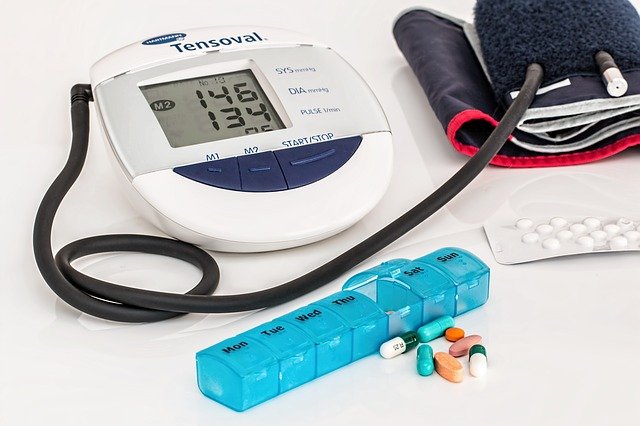How Physical Activity Can Lower Blood Pressure
Your blood pressure is one of the most important things about your physical health.
It’s a measure of how hard your heart is working and determines how well it can deliver oxygen to your body.
When you have high blood pressure, it means that the force of your heart pumping has caused damage to some small arteries in your body, which makes them narrower than they should be.
This narrow passageway for blood flow puts strain on both the artery and the heart and can eventually lead to serious life-threatening problems like stroke or kidney failure.
The good news?
High Blood Pressure (HBP) is reversible!
Physical activity can lower blood pressure by strengthening the walls of these damaged arteries and making them wider, thus lowering HBP levels significantly.
The best way to do this is to work with your doctor and figure out a safe and comfortable way of incorporating exercise into your daily life.
Remember that consistency and a regular exercise session is key, so it’s important to start slow and build up over time!
Here are some tips to keep in mind.
Do you need to get your doctor’s OK for physical activity?

Exercise isn’t right for everyone.
If you have certain medical conditions, like uncontrolled diabetes, heart failure or coronary artery disease, then check with your doctor before starting any new exercises.
Your doctor can tell you whether it would be best to lower the intensity of your exercise program or stop exercising completely until they talk to you about it.
Although generally safe, even lower impact exercises like walking can put strain on the body under certain conditions and you may need to lower your activity level or stop exercise completely.
How to check your resting heart rate.
Your resting heart rate (RHR) is the number of times your heart beats per minute while you are at rest.
To measure your RHR, take your pulse by placing your fingers on the side of your neck or find it on your wrist, just above the thumb.
Count the number of beats you feel in 10 seconds and then multiply that number by six to get your RHR.
If you’re healthy, aim for a lower RHR than 60 beats per minute.
How to calculate your BMI.

Your Body Mass Index (BMI) is a measure of how much you weigh compared to your height.
To calculate exactly, check out any online BMI calculator.
Generally speaking, lower BMIs are better for heart health.
For example, if you have a normal weight of 120 lbs and 5 feet 6 inches tall (66 inches), your BMI is 23.2.
If you are overweight at 160 lbs and 5 feet 6 inches tall (66 inches), your BMI is 27.7, lower than the normal range of 25-29.9 but still considered high for an adult of your height.
What is my target training heart rate?
Your target training heart rate (THR) is the lower end of your exercise heart range.
To calculate it, subtract your age from 220.
Multiply this number by 70% to get your THR.
For example, if you are 35 years old: 220 – 35 = 185 x 0.7 = 130.
This means that your THR at 70% of 220 beats per minute would be 130.
Any other way to know my intensity level?

You can do a simple test of your heart rate called the Talk Test.
This test will give you an indication of how hard you are working out on any given day, allowing you to lower or increase intensity as needed.
The talk test is easy to use – if you can talk easily while exercising then you’re at a lower intensity, if you can’t talk at all then that means it’s time to lower the level of exercise.
How much exercise do you need to lower blood pressure?
Ideally, you should work towards a minimum of 150 minutes per week.
This can be broken up into 10 minute-sessions throughout the day or 30 minute sessions five times a week.
150 minutes might seem like a lot, but think about how quickly it adds up: 15-20 minutes before breakfast and dinner, and 10 minutes each time you take a break at work.
For lower-intensity exercise like walking, two or three sessions per day is ideal.
You might want to consider joining a gym if you can’t find enough time in your schedule to hit the 150 minute mark every week.
Forget about no pain no gain.
It’s time to lower the intensity when you can’t carry on a conversation while exercising, experience chest pain or shortness of breath, and feel lower limb pain or discomfort in your lower back.
If you experience lower limb pain, stop exercising immediately and consult your doctor.
It could be a sign of critical ischemia or arterial occlusion, which can lead to heart attack or stroke.
Monitor your progress to see if exercise is lowering your blood pressure.

Your doctor might recommend a 24-hour blood pressure monitoring test or a home blood pressure monitor to track your progress.
If you are not already working with a doctor, make sure to see one before you start exercising.
Your physician can let you know what kind of exercise is right for your health condition and lower blood pressure.
Find fun activities whether it’s running, swimming or dancing.
There are plenty of low-impact activities to lower your blood pressure and still fit into your busy lifestyle.
The more you enjoy your exercise, the less likely you are to give it up.
Having fun is a great way to lower blood pressure!
Variety is the spice of life, and your workout.

Try zumba, yoga or tai chi to lower blood pressure if you are just getting started with lower intensity exercise.
Add 15-20 minutes of walking before breakfast and dinner every day to lower blood pressure fast!
Walking is a lower intensity exercise, which means you can do it for longer and lower your blood pressure faster.
Also, lower-intensity exercises like walking do not put as much stress on the body as high-intensity exercises.
Focus on lower-intensity exercises and then mix in some medium to high intensity routines.
Is there such a thing as the best exercise?
Specific lower-intensity aerobic exercise lower BP by 5 to 10 mmHg in people who have hypertension, while high intensity aerobic exercise can lower blood pressure by 10 to 15 mmHg.
At the end of the day, any type of physical activity will reduce blood pressure.
If you are just getting started with lower intensity exercise, try walking, running or cycling.
When you are ready to lower blood pressure even more, high intensity exercise such as strength training or general resistance exercise is the next logical step!
If swimming sounds like more fun than walking, try it out.
Once you’re comfortable with lower intensity exercises like walking and swimming, kick it up a notch with high-intensity interval training (HIIT) to lower blood pressure even more.
HIIT can lower blood pressure and works your heart and lungs as well as other muscles.
This type of exercise should be done no more than three times a week, though you might consider doing it on alternating days from lower intensity exercise.
How often should you exercise to lower blood pressure?
The general guideline is that lower intensity exercise should be performed 4 to 5 times a week and high intensity exercise should be performed no more than three times weekly.
If you are bringing your blood pressure down with lower-intensity exercise, continue to do so and add in high-intensity exercise on alternate days.
List of 8 high intensity exercises that help lower blood pressure
- Sprinting
- Jumping rope
- Swimming fast laps
- Cycling hard
- Power yoga or Pilates
- Fast walking, running or swimming uphill
- High impact plyometrics exercises like jumping jacks or burpees
- Resistance training – Weight lifting with explosive movements lifts weights
List of 10 lower-intensity exercises that have been shown to reduce blood pressure in adults by 5-10 mmHg over a period of six months or less:
- Walking
- Running slowly
- Cycling
- Swimming
- Yoga
- Pilates
- Tai chi
- Golfing
- Gardening
- Dancing
Conclusion for Physical Activity Can Lower Blood Pressure.
Working with your doctor and choosing lower or higher intensity exercises to lower blood pressure is an effective way to bring those numbers down!
There are plenty of lower and high-intensity exercise options available so you can find fun ways to lower your blood pressure.
If you’re just getting started, walking will lower your blood pressure fast.
When you are ready to lower blood pressure even more, high intensity exercise such as resistance training or isometric exercise is the next step!
Whatever activity gets you moving can lower your blood pressure.
If swimming sounds like more fun than walking, try it out.
If lower-intensity exercises like walking and swimming don’t get you excited enough to lower blood pressure, high-intensity interval training (HIIT) is the next step!
If lower intensity exercise worked for you to lower blood pressure, continue with lower intensity exercise and mix in high intensity exercises on alternate days.
Working with your doctor is the best way to lower blood pressure through exercise!
So just remember that physical activity can lower blood pressure.



Pingback: 12 Quick Steps To Lower Blood Pressure Naturally - Stop Feeling Old